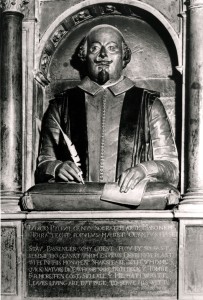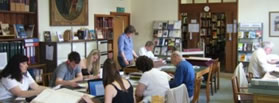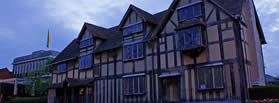 Publication of Shakespeare Beyond Doubt, the volume of essays attempting to lay to rest doubts about the authorship of Shakespeare’s works which I co-edited with Paul Edmondson, has involved me in a number of open discussions, some of them along with people who take the opposite point of view.
Publication of Shakespeare Beyond Doubt, the volume of essays attempting to lay to rest doubts about the authorship of Shakespeare’s works which I co-edited with Paul Edmondson, has involved me in a number of open discussions, some of them along with people who take the opposite point of view.
At the Stratford Literary Festival, and subsequently in a Shakespeare Birthplace Trust webinar, ‘Proving Shakespeare‘, I locked horns with Ros Barber who has published a novel called The Marlowe Papers. Made up of a series of poems written, in a conservatively modern idiom, in verse based on the iambic pentameter, it ingeniously proposes that the amply documented death in 1593 of Christopher Marlowe was (to quote the book description on Amazon) ‘an elaborate ruse to avoid being convicted of heresy; that he was spirited across the Channel to live on in lonely exile; that he continued to write plays and poetry, hiding behind the name of a colourless man from Stratford – one William Shakespeare.’ As a work of fiction the novel belongs to a genre of which numerous examples are discussed in a chapter of our book, ‘Fictional Treatments of Shakespeare’s Authorship’, by Paul Franssen, and as a novel in verse I admired and enjoyed it. But it was disconcerting to find that its author believes her own thesis, summarily denying the evidence of the report of the coroner’s inquest on Marlowe along with the record of his burial discovered and published in 1925 by Leslie Hotson. Marlowe, she writes in a note, ‘is supposed to have been buried in an unmarked grave in the grounds of St Nicholas Church Deptford.’ It would have been fairer to say that the church records provide documentary evidence of his burial rather than representing it as mere supposition.
During our discussion she referred me to Diana Price’s book Shakespeare’s Unorthodox Biography: New Evidence of an Authorship Problem (2001; reprinted and revised 2012) as an authoritative statement of the anti-Shakespearian case. It aims (to quote Amazon again) to prove ‘that William Shakespeare of Stratford was a successful entrepreneur, financier, play broker, businessman, theater shareholder, real estate investor, commodity trader, moneylender, and shareholding actor, but not a dramatist. It further proposes that the works of “William Shakespeare” were written by an unnamed gentleman of rank.’
Price’s book is a work of impressive, if misguided, scholarship. She ranges far and wide over historical, biographical, literary, bibliographical, theatrical, and dramatic evidence in what is surely the most determined attempt ever made to destroy the Shakespearian case. She creates an impression of great authority which may well delude unsuspecting readers into accepting her thesis. But it has fatal weaknesses. Here are some of them.
Price is as willing as her opponents to cite legends rather than facts. Several times she cites what she admits (p. xiv) is a ‘legend’, a ‘tradition’ (p. 242) that Shakespeare of Stratford left school early, when he was no more than thirteen years old. In fact, as she frequently tells us, we have no documentary evidence that he even attended school, let alone when he stopped doing so. She writes that he grew up in a home ‘filled with illiterate people’ (p. 242) and that he ‘retired to an illiterate household at the height of his literary powers’ (a judgement which itself could be questioned). At other points she attempts to denigrate Shakespeare of Stratford’s literary reputation by proposing that his wife and daughters were illiterate. Yet she has to admit that Susanna, married to a distinguished and learned physician, could at least sign her name, and she ignores the evidence of Susanna’s epitaph that she was ‘witty [intelligent] above her sex.’ (In any case literary fathers can have illiterate daughters.) Rather similarly she writes of Stratford as an educational backwater while quoting John Hall’s description of one of the Quineys – a family into which Judith Shakespeare married – as ‘a man of good wit, expert in tongues, and very learned.’ (p. 237).
Price misleadingly says that ‘there are ‘no commendatory verses to Shakespeare’, ignoring those printed in the First Folio as well as the anonymous prose commendation in the1609 edition of Troilus and Cressida and that by Thomas Walkley in the 1622 quarto of Othello. Her statement that ‘nothing marked Shakespeare’s demise until seven years after his death’ ignores the fact that the monument in Holy Trinity, with its inscriptions eulogizing Shakespeare of Stratford as a writer, would have taken time to design and prepare and that it may have been erected any time before we first hear of it, in 1623; and if Price’s remark refers to publication in 1623 of the First Folio, it ignores the fact that big books take a long time to compile and to produce. Still more importantly, Price downplays William Basse’s elegy on Shakespeare which ranks him with Chaucer, Spenser, and Beaumont and which could have been written any time after Shakespeare died, and which circulated widely in manuscript – at least 34 copies are known – before and after it was published in 1633, and she fails to note that one of the copies is headed ‘bury’d at Stratford vpon Avon, his Town of Nativity’.
Price more than once advances eccentric interpretations of contemporary documents to bolster her case. She interprets John Aubrey’s statement that Shakespeare ‘wouldn’t be debauched & if invited to writ: he was in pain’ to mean, not, as is surely right, ‘wrote that he was in pain’ but ‘if Shakespeare was asked to write, he begged off with a sore hand.’ (p. 128) Rather similarly, in the Parnassus plays Gullio quotes from Romeo and Juliet, provoking from Ingenioso the response ‘Mark, Romeo and Juliet: o monstrous theft! I think he will run through a whole book of Samuel Daniel’s.’ Price interprets this as an implication that Daniel wrote Romeo and Juliet, while admitting that the first quarto, Meres, and Weever (let along the First Folio) all attribute the play to Shakespeare. The more natural interpretation is surely ‘if he can do that, he can probably quote a whole book by Daniel.’ And discussing Shakespeare’s relationship with the Earl of Southampton she states that the dedication to Lucrece is ‘equally formal’ as that to Venus and Adonis as if the words ‘The love I dedicate to your lordship is without end’ were a mere formality.
Like many other anti-Shakespearians Price irrationally casts doubt on posthumously derived evidence, even to the extent of doubting the First Folio’s statement that Shakespeare acted in his own plays on these grounds (p. 41).
Attempting to show that there is no evidence that the Stratford man was a writer Price offers a detailed discussion of William Dugdale’s sketch, made around 1634, of the Stratford monument, which she accepts as an effigy of the Stratford Shakespeare, but fails to take note of Dugdale’s statement that it portrays ‘william Shakespeare the famous poet’ even though she reproduces it (Figure 19).
Although Price accepts the Sonnets as autobiographical when it suits her case to do so, she ignores No. 136, which by that token shows that the author’s name was Will. This would at least narrow down the number of aristocrats eligible by her account for consideration as the author of the works.
And, of course, she can produce not a single scrap of positive evidence to prove her claims; all she can do is systematically to deny the evidence that is there.
I disagree with many other judgements in Price’s book, but I have tried to select for discussion those that are most demonstrably wrong or unfair. Its aims are entirely destructive and it is not the definitive work that it claims to be.





